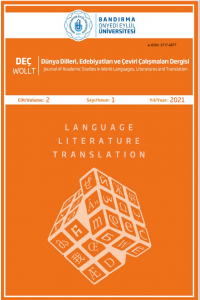Öz
Anahtar Kelimeler
Doppelganger corporeal and incorporeal Kieslowski Freud the uncanny
Kaynakça
- Derry, J. (2010). Incorporeal Encounters and Affective Relationality in Krzysztof Kieslowski’s The Double Life of Véronique. Intersections 2010: "Encounters: Situating 'Relation' in Communication and Culture (Vol. 9).
- Freud, S. (2003). The Uncanny (D. McLintock, Trans.; H. Haughton, Ed.). New York: Penguin Books.
- Haltof, M. (2012). The Cinema of Krzysztof Kieslowski: Variations on Destiny and Chance. New York: Columbia University Press.
- Hoffmann, E. (1982). Tales of Hoffmann (R. J. Hollingdale, Trans.). Harmondsworth: Penguin Books.
- Hoppe, K. (1964). Psychoanalytic Remarks on Schnitzler's "Fräulein Else". Journal of the International Arthur Schnitzler Research Association, 3(1), 4-8. doi:10.2307/45275152
- Kickasola, J. G. (2009). Kieślowski Crosses the Atlantic. In S.Woodward (Ed.), After Kieslowski: The Legacy of Krzysztof Kieslowski (pp. 165-185). Detroit, MI: Wayne State University Press.
- Kupper, H. I., & Rollman-Branch, H. S. (1959). Freud and Schnitzler-(doppelgänger). Journal of the American Psychoanalytic Association, 7(1), 109-126. doi:10.1177/000306515900700105
- Lacan, J. (2005). Ecrits (B. Fink, Trans.). New York: W. W. Norton
- Santilli, P. C. (2006). Cinema and Subjectivity in Krzysztof Kieslowski. The Journal of Aesthetics and Art Criticism, 64(1), 147–156. doi: 10.1111/j.0021-8529.2006.00236.x
- Schnitzler, A. (1998). Fraulein Else (F. H. Lyon, Trans.). London: Pushkin Press.
- Stok, D. (1993). Kieslowski on Kieslowski. London: Faber and Faber
Öz
Anahtar Kelimeler
Doppelganger corporeal and incorporeal Kieslowski Freud the uncanny
Kaynakça
- Derry, J. (2010). Incorporeal Encounters and Affective Relationality in Krzysztof Kieslowski’s The Double Life of Véronique. Intersections 2010: "Encounters: Situating 'Relation' in Communication and Culture (Vol. 9).
- Freud, S. (2003). The Uncanny (D. McLintock, Trans.; H. Haughton, Ed.). New York: Penguin Books.
- Haltof, M. (2012). The Cinema of Krzysztof Kieslowski: Variations on Destiny and Chance. New York: Columbia University Press.
- Hoffmann, E. (1982). Tales of Hoffmann (R. J. Hollingdale, Trans.). Harmondsworth: Penguin Books.
- Hoppe, K. (1964). Psychoanalytic Remarks on Schnitzler's "Fräulein Else". Journal of the International Arthur Schnitzler Research Association, 3(1), 4-8. doi:10.2307/45275152
- Kickasola, J. G. (2009). Kieślowski Crosses the Atlantic. In S.Woodward (Ed.), After Kieslowski: The Legacy of Krzysztof Kieslowski (pp. 165-185). Detroit, MI: Wayne State University Press.
- Kupper, H. I., & Rollman-Branch, H. S. (1959). Freud and Schnitzler-(doppelgänger). Journal of the American Psychoanalytic Association, 7(1), 109-126. doi:10.1177/000306515900700105
- Lacan, J. (2005). Ecrits (B. Fink, Trans.). New York: W. W. Norton
- Santilli, P. C. (2006). Cinema and Subjectivity in Krzysztof Kieslowski. The Journal of Aesthetics and Art Criticism, 64(1), 147–156. doi: 10.1111/j.0021-8529.2006.00236.x
- Schnitzler, A. (1998). Fraulein Else (F. H. Lyon, Trans.). London: Pushkin Press.
- Stok, D. (1993). Kieslowski on Kieslowski. London: Faber and Faber
Ayrıntılar
| Birincil Dil | İngilizce |
|---|---|
| Bölüm | Araştırma Makalesi |
| Yazarlar | |
| Yayımlanma Tarihi | 30 Haziran 2021 |
| Gönderilme Tarihi | 15 Mayıs 2021 |
| Yayımlandığı Sayı | Yıl 2021 Cilt: 2 Sayı: 1 |

